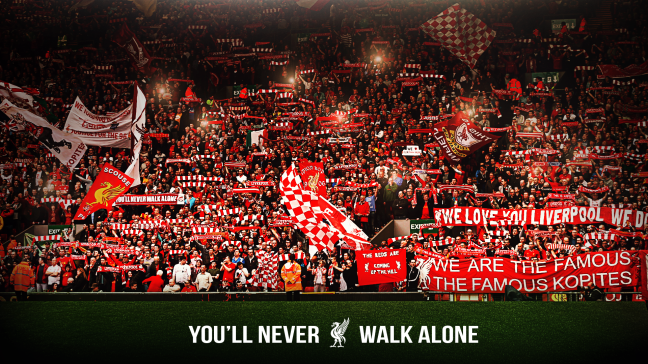This may be a bit late but in honour of the TRUTH behind Hillsborough tragedy and the aftermath of that famous comeback against Borussia Dortmund I had worked on an academic writing piece based on Liverpool Football Club and the famous anthem of ‘You’ll Never Walk Alone’. Enjoy!

In this essay I will discuss as well as analyse one of the most iconic songs in sport and the various images, emotions and conceits that it contains and evokes out of its listeners and singers alike. The song that I will discuss in this essay is one that has become as iconic as the sport and club with which it is associated, Liverpool Football Club’s anthem of “You’ll Never Walk Alone” by Gerry and the Pacemakers.
This song carries inexplicable amounts of sentiment to those who revere and cherish the beauty of this musical master class. Sung by millions all over the world regardless of their ties with Liverpool FC or not this song has reached out to individuals in the most difficult of times. Before divulging into the main topic of discussion, here is an extract of the song’s lyrics below:
When you walk through a storm, hold your head up high
And don’t be afraid of the dark
At the end of the storm, there’s a golden sky
And the sweet, silver song of a lark
Walk on through the wind
Walk on through the rain
Though your dreams be tossed and blown
Walk on, walk on
With hope in your heart
And you’ll never walk alone
You’ll never walk alone
Walk on, walk on
With hope in your heart
And you’ll never walk alone
You’ll never walk alone
(Gerry and The Pacemakers 1963)

Firstly, some background history about the world-famous Anfield anthem in order to contextualise the matter. The song was originally written by the pair of “Richard Rodgers and Oscar Hammerstein who wrote it for their musical Carousel in 1945” (Kop Left 2016). Hammerstein wrote the lyrics while Rodgers had composed the required music. In the same year, Frank Sinatra had become the first well-renowned artist to do his own rendition which eventually ended up being ranked ninth “on the Billboard charts in 1945” (Songfacts 2016).
The Football Supernova’s Antoine Choueri provides a more in-depth look at the song that is no0w etched in Liverpool folklore, not just the football club but the city as a whole. He looks back to a time just after World War II had begun where “what [was] arguably the biggest empire in history is on the brink of defeat. In the North-West of England, between the River Mersey and the Irish Sea, Liverpool is witnessing the heaviest destruction it has ever seen, being the most bombed city in the Nazi Blitz after London” (Choueri 2012). In addition, Antoine Choueri much like me is “a die-hard Liverpool fan” who has a better knowledge of and claims to know “the club’s history inside out” (Choueri 2012).
According to Choueri, “Fast-forward a couple of decades later, and Liverpool has barely recovered from the Blitz and post-war crises. The birth of the Manchester Ship Canal means the ships coming from America and the rest of the world would bypass the destructed Liverpool Docks to go straight to Manchester. What was once the Empire’s second-city and the biggest seaport in the world is on the verge of extinction, half of the city’s inhabitants having fled to London or the US” (Choueri 2012).
This may all seem overly-contextualised but the aforementioned explanation courtesy of Antoine Choueri makes reference to the lyrics, “When you walk through a storm, hold your head up high” (Gerry and The Pacemakers line 1). The proverbial ‘storm’ refers to the tough times that England’s once proclaimed “second-city” (Choueri 2012) were experiencing.
A once-great city in a state of turmoil and under threat of becoming obsolete had then begun to see an upturn in their fortunes as the early 1960s rolled in.
Liverpool the city, began to see its “the golden sky” (Gerry and The Pacemakers 3) like the song goes, as pivotal events had taken shape. A 47-year-old Scotsman by the name of William Shankly had entered the helm “to manage a mediocre Division Two Liverpool FC side. On July that same year, four teenagers change their band name from “Silver Beatles” to “The Beatles”. Liverpool was meant to change history forever” (Choueri 2012).

Almost like clockwork, Shankly’s Liverpool FC were back in the top-tier of English football challenging for the title while The Beatles had a host of number one hits which had lead “the Merseybeat movement” (Choueri 2012) by 1963.
“At the end of the storm, there’s a golden sky” (Gerry and The Pacemakers 3) points to the upturn of Liverpool’s fortunes as The Beatles’ top-chart records accompanied by Bill Shankly’s mighty Reds had helped put the once extinction-bound city back on the map.
Choueri (2012) explains how Liverpool’s world-famous ‘Kop’ end, the terrace where the Liverpool home fans are seated had erupted to the tune of “You’ll Never Walk Alone” “on one cold November afternoon” (Choueri 2012). “The Kop suddenly erupts into singing a tune one would have thought they’d known for ages” (Choueri 2012), this had added to the romanticism associated with Scousers and music but the irony of it all was that the fans had taken to the tune like a fish to water.
“As the years went by and silverware ridiculously piled up in the Anfield Trophy Room, the song vigorously accompanied the men in red, win or defeat, home or away, locally or abroad” (Choueri 2012). Liverpool FC’s home ground, Anfield had become a cathedral of 30,000-plus fans singing “You’ll Never Walk Alone” in unison before, during and after matches. The atmosphere that this sheer, awe-inspiring tune had created was nothing short of bone-chilling, goose-bump filled moments that helped usher in the club’s most successful period in its rich 124-year history.
It was in the midst of Liverpool’s ‘roaring 60s and 70s’ that the “You’ll Never Walk Alone” had become the club’s official anthem while, “a banner containing the song’s title was added to the Liverpool Football Club’s official emblem” (Songfacts 2016). Other football clubs such as Scotland’s Celtic Glasgow and Germany’s Borussia Dortmund soon followed suit and adopted the famous tune as a club anthem and pre-match ritual.
In a sense, Liverpool FC and more importantly Gerry and The Pacemakers can be regarded as pioneers of the modern football atmosphere as what was once just a theatre for football and noisy clapping and roaring had transformed. Transformed into a cauldron of “noise volume, humour, generosity, banners, flags, scarves, originality, creativity, and most importantly, its unity made it the most famous football terrace in the world” (Choueri 2012).
This song made fans unite in chorus and has been regarded as ‘the 12th man’ that has been known to get their men in red across the line on numerous occasions throughout history.
“Walk on through the wind/ Walk on through the rain” (Gerry and The Pacemakers 5-6) are the persevering words that inspire not only Liverpool FC fans but the players as well to continue to fight and believe with passion. “Though your dreams be tossed and blown” (Gerry and The Pacemakers 7) points to the evident struggles of both the city and the club which had been met with the persevering “Walking on through the wind [and] rain” (Gerry and The Pacemakers 5-6).
Undoubtedly, “You’ll Never Walk Alone” has united fans worldwide and willed the players on through the toughest of times.
Nothing is more evident of this than the club’s periods of ultimate high and ultimate low. This being the ‘Hillsborough tragedy’ in 1989 and The Champions League Final in Istanbul 2005 respectively. “On the 15th of April 1989, 96 Liverpool fans went to watch their beloved side go through to yet another Cup final, but never made it home”. The city of Liverpool stood together and “united, mourning and standing by its own, those 96 brothers who lost their lives at a football match. The first football game Liverpool played after the disaster was a friendly at Celtic, set up as a tribute to the 96, and both sets of fans went on to sing their anthem in unison in the most emotional way. Similar scenes at Wembley, just before the FA Cup final between Liverpool and Everton, where 90,000 Scousers sang YNWA, reminding the world that there are things that are just bigger than football, and their rivalry was only on the pitch”(Choueri 2012). The events of Hillsborough still live long in the memory of those who were there that day and those who continue to show their support with the common denominator being the famous words of, “You’ll Never Walk Alone”.
The evening of May 25th 2005 marked Liverpool FC’s first European Cup final in over 15 years and had kicked off in ‘tragic’ fashion after being ‘left for dead’ at 3-0 to Italy’s AC Milan. Almost as if they were scenes from a Hollywood box office best-seller, The Reds had emerged from the half time break to the most emphatic, emotional and passionately sung “You’ll Never Walk Alone” that had spurred the Reds on to come from behind and win the cup on penalties in the most dramatic of finals in history.
It is abundantly clear that this anthem, a hymn if you will, passionately unites people beyond more than just the game of football. It evokes emotions out of the most stern of characters in time of deep sorrow as well as incredible jubilation. It is more than just a song or anthem but rather a symbol of hope and remembrance.
